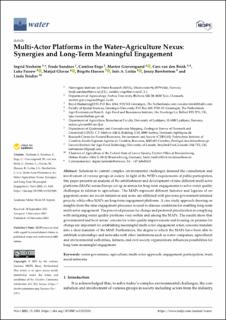| dc.contributor.author | Nesheim, Ingrid | |
| dc.contributor.author | Sundnes, Frode | |
| dc.contributor.author | Enge, Caroline | |
| dc.contributor.author | Graversgaard, Morten | |
| dc.contributor.author | van den Brink, Cors | |
| dc.contributor.author | Farrow, Luke | |
| dc.contributor.author | Glavan, Matjaž | |
| dc.contributor.author | Hansen, Birgitte | |
| dc.contributor.author | Leitão, Inês A. | |
| dc.contributor.author | Rowbottom, Jenny | |
| dc.contributor.author | Tendler, Linda | |
| dc.date.accessioned | 2021-12-10T11:53:48Z | |
| dc.date.available | 2021-12-10T11:53:48Z | |
| dc.date.created | 2021-12-02T10:59:26Z | |
| dc.date.issued | 2021 | |
| dc.identifier.citation | Water. 2021, 13 (22), 3204. | en_US |
| dc.identifier.issn | 2073-4441 | |
| dc.identifier.uri | https://hdl.handle.net/11250/2833772 | |
| dc.description.abstract | Solutions to current complex environmental challenges demand the consultation and involvement of various groups in society. In light of the WFD’s requirements of public participation, this paper presents an analysis of the establishment and development of nine different multi-actor platforms (MAPs) across Europe set up as arenas for long-term engagements to solve water quality challenges in relation to agriculture. The MAPs represent different histories and legacies of engagement; some are recent initiatives and some are affiliated with previous government-initiated projects, while other MAPs are long-term engagement platforms. A case study approach drawing on insights from the nine engagement processes is used to discuss conditions for enabling long-term multi-actor engagement. The perceived pressure for change and preferred prioritization in complying with mitigating water quality problems vary within and among the MAPs. The results show that governmental and local actors’ concern for water quality improvements and focusing on pressure for change are important for establishing meaningful multi-actor engagement when concerns translate into a clear mandate of the MAP. Furthermore, the degree to which the MAPs have been able to establish relationships and networks with other institutions such as water companies, agricultural and environmental authorities, farmers, and civil society organizations influences possibilities for long-term meaningful engagement. | en_US |
| dc.language.iso | eng | en_US |
| dc.publisher | MDPI | en_US |
| dc.rights | Navngivelse 4.0 Internasjonal | * |
| dc.rights.uri | http://creativecommons.org/licenses/by/4.0/deed.no | * |
| dc.title | Multi-Actor Platforms in the Water–Agriculture Nexus: Synergies and Long-Term Meaningful Engagement | en_US |
| dc.type | Peer reviewed | en_US |
| dc.type | Journal article | en_US |
| dc.description.version | publishedVersion | en_US |
| dc.rights.holder | © 2021 by the authors | en_US |
| dc.source.pagenumber | 20 | en_US |
| dc.source.volume | 13 | en_US |
| dc.source.journal | Water | en_US |
| dc.source.issue | 22 | en_US |
| dc.identifier.doi | 10.3390/w13223204 | |
| dc.identifier.cristin | 1963238 | |
| dc.relation.project | EC/H2020/727984 | en_US |
| dc.source.articlenumber | 3204 | en_US |
| cristin.ispublished | true | |
| cristin.fulltext | original | |
| cristin.qualitycode | 1 | |

